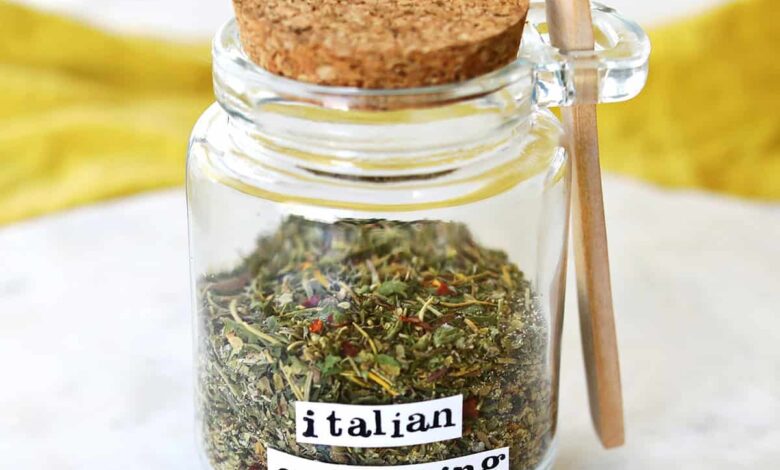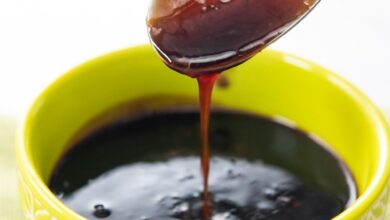Italian Seasoning – A Beautiful Mess

Once you learn to make homemade Italian Seasoning, you never go back! I use mine constantly to season pastas, pasta sauces, soups, proteins, potatoes, lasagne and make pizzas. The best part is this seasoning recipe is made with ingredients you probably already have in your spice drawer.
Related: Fajita Seasoning, Chili Seasoning, Taco Seasoning, Cajun Seasoning.

Italian Seasoning Blend Ingredients
- Dried Basil
- Dried Thyme
- Dried Rosemary
- Dried Marjoram
- Dried Parsley
- Dried Oregano
- Garlic Powder
- Red Pepper Flakes

How to Make
Prepare your ingredients. Measure each spice into a small bowl.
Stir gently to blend, or seal the container and shake.
Store in an airtight container.
Optional step: If your rosemary (or other spices) are not fine enough for your taste, you may use a mortar and pestle to grind the spice mixture to a more fine texture before storing.

Tips for Making
- Use this seasoning to make your own Italian bread dipping oil. Simply mix together half a cup olive oil, 1-2 minced garlic cloves and 1 tablespoon of our Italian Seasoning. Serve in a shallow dish for bread dipping.
- You can customize this recipe to your diet by removing ingredients you are allergic to or dislike and control the spice level.
- This recipe can be tweaked with what you have on hand or to your personal taste. Feel free to adjust the ratios to suit your preference. You can also use dried minced garlic instead of powder if you want a little more texture.
- I make my own sugar-free spaghetti sauce often by combing a cup of tomato sauce with 2 teaspoons of Italian seasoning.
How much seasoning is in one packet?
If you are using a recipe that calls for “one packet” of store-bought seasoning, you are probably curious how much homemade mix is equal to “one packet.” One packet is typically equivalent to one ounce, or three tablespoons of seasoning.
Shelf life
A batch of homemade seasoning can last in your pantry for one to two years. For peak freshness, use within six months. This is likely obvious, but using fresher spices will result in a longer shelf life. So if this is a concern to you, don’t use spices that have been sitting in your drawer for years.

More Spice Blends
Why homemade seasoning is best
- Best ingredients – Homemade seasoning is great because you can be sure what is in it (and what is not in it). If you avoid sugar, salt, dairy or gluten, making your own seasonings can give you peace of mind. You can also choose to use all organic spices if you wish.
- Unlimited supply – If you make Italian food as often as we do, it’s annoying to rely on store-bought seasoning packets. This way, I always have what I need and if I run out I can always make more.
- Tastes amazing – I swear by the flavors in this recipe. It tastes so good and my whole family loves it.
- You can tweak the spice level – This recipe isn’t spicy, but if you are extremely sensitive and don’t want any spice at all, you can omit the red pepper flakes. You can also add more if you prefer more of a kick.
- Prep time – The total prep time for making a homemade Italian seasoning mix is less than five minutes. It’s as simple as mixing herbs and spices together and storing them in a jar.

Frequently Asked Questions
What is in Italian Seasoning?
Italian Seasoning is made with basil, thyme, rosemary, marjoram, parsley, oregano, red pepper flakes and garlic powder.
Do Italian people use oregano in cooking?
Oregano is more common in American Italian dishes than authentic Italian dishes. The most popular spices to use in Italian cooking are parsley and basil.

Favorite recipes to use Italian seasoning
Get our FREE recipe guide with our most popular recipes of all time!

Free Popular Recipe Guide
Our top 25 recipes of all time!
Get the Recipe
Learn to make Italian Seasoning, which is made with basil, thyme, rosemary, marjoram, parsley, oregano, red pepper flakes and garlic powder.
Instructions
-
Prepare your ingredients. Measure each spice into a mixing bowl.
-
Stir gently to blend, or seal the container and shake.
-
Store in an airtight container.
Notes
- You can customize this recipe to your diet by removing ingredients you are allergic to or dislike and control the spice level.
- This recipe can be tweaked with what you have on hand or to your personal taste. Feel free to adjust the ratios to suit your preference. You can also use dried minced garlic instead of powder if you want a little more texture.
- A batch of homemade seasoning can last in your pantry for one to two years. For peak freshness, use within six months.
Nutrition
Nutrition Facts
Italian Seasoning
Amount per Serving
% Daily Value*
* Percent Daily Values are based on a 2000 calorie diet.
Notice: Nutrition is auto-calculated, using Spoonacular, for your convenience. Where relevant, we recommend using your own nutrition calculations.
Source link




